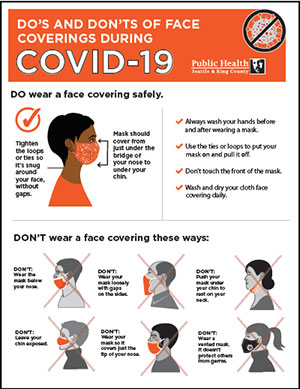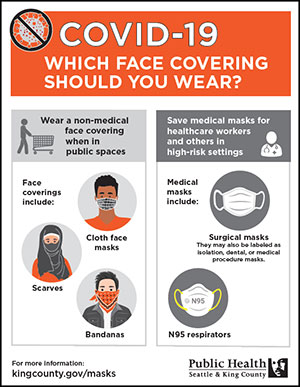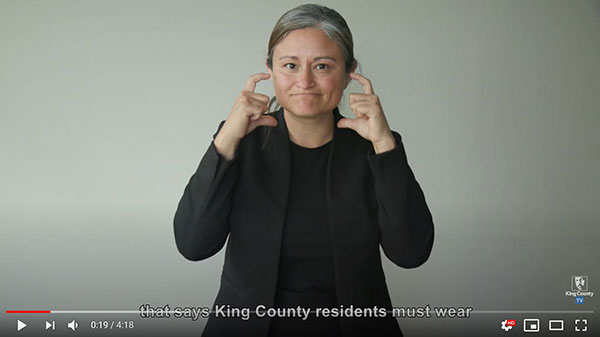Masks and Face Coverings Help Stop the Spread of COVID
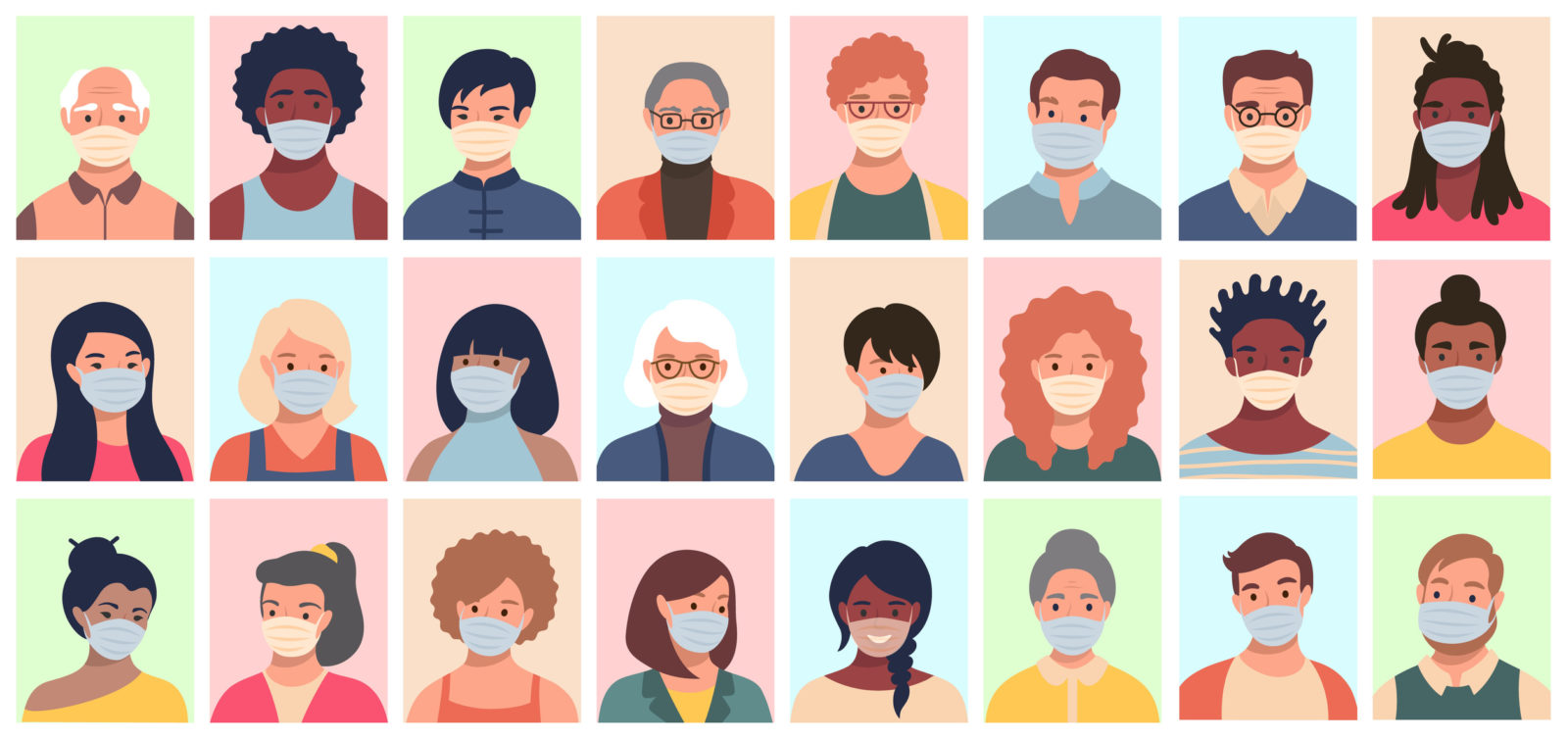
Staying home is still the safest way to prevent spreading COVID-19. Older people and anyone else in a higher risk category (e.g., people with chronic conditions such as heart disease, diabetes, or COPD, and people with auto-immune diseases) are strongly encouraged to stay home until there is a COVID-19 vaccine. If you do go out, wear a face covering, stay six feet apart from others, and wash your hands or use hand sanitizer frequently.
You have probably heard that face coverings are required statewide in all public spaces to help slow the spread of the coronavirus. We know there’s a lot of misinformation and many people have questions. Let’s look at the who-what-where-when-why-and-how of wearing a face covering during the COVID pandemic.
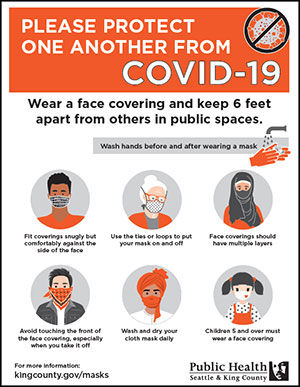
Wear a face covering and keep 6 feet apart from others in public spaces. Click on the image above to open a PDF.
Who must wear a face covering in public?
At the time this article was written, three statewide orders about face coverings were in place:
- All people, with few exceptions, are required to wear a face covering in any indoor public setting or when outdoors and unable to maintain six feet of physical distance from others.
- Employers are required to provide appropriate face coverings to all employees who don’t work alone.
- Businesses are directed to require and enforce the use of face coverings by all customers and visitors.
What are the exceptions?
The following individuals are exempt from the requirement to wear a face covering:
- Children under two years old should never wear face coverings due to the risk of suffocation.
- Children who are two, three, or four years old are strongly recommended to wear face coverings at all times in settings where it is likely that a distance of at least six feet cannot be maintained from non-household members and where vulnerable people must go (e.g., grocery stores, pharmacies). Young children should always have the assistance and close supervision of an adult.
- Persons with a medical condition, mental health condition, or disability that prevents wearing a face covering. This includes, but is not limited to, persons with a medical condition for whom wearing a face covering could obstruct breathing or who are unconscious, incapacitated, or otherwise unable to remove a face covering without assistance.
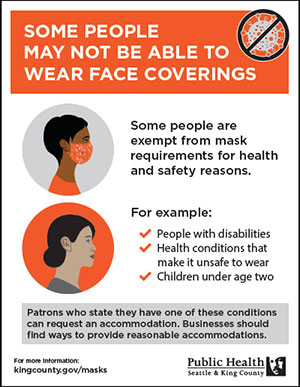
Learn who is exempt from mask requirements for health and safety reasons. Click on the image above to open a PDF.
What kind of face covering is required?
Cloth face coverings are recommended (not medical grade masks). Cloth face coverings take many forms. We published an article (What’s the Skinny on COVID-19 Face Masks?) in May that includes links to sew and no-sew face coverings. Also in May, our friends at Public Health—Seattle & King County published D.I.Y. Face Coverings: Tips on Making Cloth Masks from the Public Health Crafter’s Corner.
Now most major retailers sell a variety of mask and face covering options. For some people, masks are a new fashion statement—which is fine, if the masks do what is needed to protect from coronavirus. To protect yourself and others, consider the following:
- Is the mask large enough to cover my nose and mouth at all times?
- Are there at least two layers of fabric in the mask?
- Will ear loops or straps feel most comfortable?
- Will the mask hug my nose and not gape on any side?
- Is the mask washable (therefore reusable after laundering)?
- How many masks will I need if I’m unable to do laundry every day?
Where and when are face coverings required?
The short answer is “anywhere you are unable to maintain six feet or more of physical distance from anyone who is not a member of your immediate household.” This includes healthcare settings (including pharmacies), any place you may need to wait in line (e.g., coffee shops, bus stops), on public transportation and in rideshare vehicles, and in outdoor public areas, including parks, trails, streets, sidewalks, entrance and exit lines, and recreation areas.
The order allows individuals to remove face coverings under specific circumstances:
- While seated at a restaurant or other food or beverage establishment and while eating or drinking if they can maintain a distance of at least six feet from other guests.
- While engaged in indoor or outdoor exercise activities if they can maintain a distance of at least six feet from non-household members. People engaged in team sports activities have special requirements.
- While in an outdoor public area, if they can maintain a distance of at least six feet from non-household members.
- When any party to a communication is deaf or hard of hearing and not wearing a face covering is essential to communication.
- While obtaining a service that requires temporary removal of the face covering.
What about those of us who cannot hear or see?
Public Health—Seattle & King County offers “Information on Face Coverings for Deaf, Hard of Hearing, and Blind Community Members”—a handout with tips on wearing a face mask if you have a hearings aid, cochlear implant and/or glasses. The same handout lists alternative ways to communicate, including print materials, visual tools, remote captioning service, smart phone apps, dry-erase boards, video-conference calls and tips for health care professionals and anyone who serves a client or customer who is deaf, hard of hearing, or deaf-blind.
Why do we have to wear masks now?
The cloth face covering I wear helps to protect you in case I have picked up coronavirus. The cloth facing covering you wear helps to protect me in case you have picked up the virus.
When the coronavirus outbreak was new, public health experts didn’t know that between 20 percent and 40 percent of people with COVID-19 are asymptomatic—which means they don’t show symptoms but can still spread the disease to others. Research now shows that face coverings significantly reduce the rate at which COVID spreads. An investment in face masks now—whether you make them yourself or purchase them—will help each of us stay safe until a vaccine is developed.
How can I get more information?
Reliable information about COVID-19 with good tips for preventing transmission are available from public health experts at Public Health—Seattle & King County and the Centers for Disease Control. For information about Washington State’s Safe Start plan, visit coronavirus.wa.gov.
Contributor Irene Stewart manages communications for Aging and Disability Services and is editor of AgeWise King County.
This article originally appeared in the August 2020 issue of AgeWise King County.
![Aging & Disability Services for Seattle & King County [logo]](https://www.agingkingcounty.org/wp-content/themes/sads/images/seattle-ads-logo.png)
